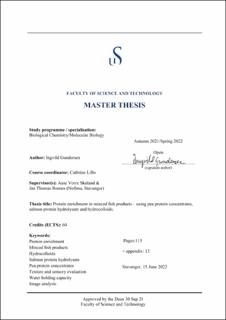| dc.description.abstract | The world population is in rapid growth with demand for an improved utilization of already existing protein sources, along with development of new and sustainable ones. Therefore, the main objective of this thesis was to perform a pilot production and a shelf-life study to develop protein enriched minced fish products with edible soft texture. Protein sources from both animal (salmon protein hydrolysate (FPH)) and plant (pea protein concentrate (PPC) and texturized pea protein concentrate (TPP)) in combination with hydrocolloids, were used to produce protein enriched minced fish products, in addition to protein enriched minced fish burgers.
Pilot production testing of minced fish products added 3% starch from potato, tapioca, modified corn and native- and modified pea showed varied texture and sensory properties. The softest texture was observed for products added native pea starch. Samples added potato- and modified cornstarch had significantly (p < 0.001) higher gel-strength than all other samples. Minced fish products added potato starch and native pea starch were further evaluated in a shelf-life study with storage at 4C for 35 days to evaluate one firmer and one softer product. The samples were pasteurized at 90C for 10 minutes before repacked in plastic trays with modified atmosphere (47% CO2 and 53% N2). Analyses of texture, color, sensory properties, water holding capacity (WHC) and microbiology showed homogenous samples with small textural differences over time. All samples had a shift in color from green to redder on day 35 indicating signs of spoilage. Hence, a safe microbiological quality and shelf-life was concluded to be 28 days.
Protein enriched minced fish samples at varying levels gave total protein content between 18.29-22.34%, and burgers with 4% protein yielded a total protein content of 22.34% with FPH and 20.70% with PPC. Texture measurements showed that increasing amount of protein increased the hardness and gumminess in the products, especially with PPC and TPP. Simultaneously, addition of FPH maintained a softer texture compared to PPC and TPP and improved the WHC in both minced fish products and burgers. More protein added also made the products more yellow in color and a darker shade. Image analysis of protein enriched products showed evenly distribution of proteins in the gelatinization structure. Hence, the area threshold correlated with increasing protein content. Salmon protein hydrolysate and pea protein concentrates were concluded to be sustainable sources of proteins added minced fish and may be utilized in the food industry in the future. | |
